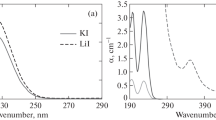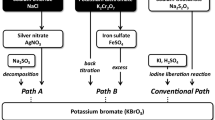Summary
It has been shown that a 0,01 N potassium bi-iodate solution can be substituted for the standard 0,01 N hydrochloric acid used in all acidimetric and alkalimetric titrations employed in quantitative organic microanalysis. The same solution also serves as a standard for the 0,01 N sodium thiosulfate solution used in iodometric titrations. No influence (oxidation, etc.) upon the organic compound nor the organic solvents employed in these titrations was observed, nor were there any changes necessary in the various procedures. This substitution results in simplification in the preparation and standardization of the various solutions involved, and furthermore, eliminates the use of a microchemical balance altogether.
Zusammenfassung
Es konnte gezeigt werden, daß eine 0,01 n-Lösung von Kaliumbijodat die 0,01 n-Salzsäure in allen acidimetrischen und alkalimetrischen Titrationen in der quantitativen organischen Mikroanalyse zu ersetzen vermag. Die gleiche Lösung kann zur Stellung der 0,01 n-Natriumthiosulfatlösung verwendet werden. Der Gebrauch einer Kaliumbijodatlösung vereinfacht die ganze organische mikrochemische Maßanalyse, um so mehr als zur Herstellung und Titerstellung aller nötigen Lösungen der Gebrauch einer Mikrowaage sich erübrigt.
Similar content being viewed by others
Literatur
A. Elek andR. A. Harte, Ind. Engin. Chem., Analyt. Ed.8, 487 (1936);9, 539 (1937). —A. Friedrich, Die Praxis der quantitativen organischen Mikroanalyse, p. 173. Leipzig and Vienna 1933. —I. M. Kolthoff andMenzel, Die Maßanalyse, p. 377. Berlin 1931. —I. M. Kolthoff andN. H. Furman, Volumetric Analysis, II, p. 109, 110. New York 1929. —H. Roth andE. B. Daw, Quantitative Organic Micro Analysis ofFritz Pregl, pp. 148 to 154. Philadelphia 1937.
J. B. Niederl andV. Niederl, Micromethods of Quantitative Organic Elementary Analysis, pp. 44, 45. New York 1938. —F. Pregl (H. Roth), Die quantitative organische Mikroanalyse, pp. 183 to 190. Berlin 1935.
M. K. Zacherl andH. G. Krainick, Mikrochemie11, 61 (1933).
E. Abderhalden andN. Fodor inAbderhaldens Handbuch der biologischen Arbeitsmethoden, Abt. I, Teil 3, p. 417. Vienna and Berlin. —I. Bang, Blutuntersuchungen, pp. 19, 33. Wiesbaden 1922. —M. Ljungdahl, Biochem. Ztschr.96, 325 (1919).
W. Geilmann andR. Höltje, Ztschr. anorgan. allg. Chem.152, 69 (1926).
J. Lindner, Ztschr. analyt. Chem.91, 105 (1933). —S. P. L. Sörensen andA. C. Andersen, ibid.45, 217 (1906).
G. Lunge, Ztschr. angew. Chem.17, 195, 225, 231, 265 (1904);18, 1520 (1905).
95 Madison Avenue, New York, N. Y.
P. A. Shaffer andA. F. Hartmann, Journ. biol. Chemistry45, 376 (1921).
S. P. L. Sörensen andA. C. Andersen, Ztschr. analyt. Chem.45, 217 (1906).
Additional information
Contribution from the Chemical Laboratories of New York University
Rights and permissions
About this article
Cite this article
Niederl, J.B., Niederl, V. & Eitingon, M. Standard solutions in quantitative organic microanalysis. Mikrochemie 25, 143–150 (1938). https://doi.org/10.1007/BF02714757
Received:
Published:
Issue Date:
DOI: https://doi.org/10.1007/BF02714757




